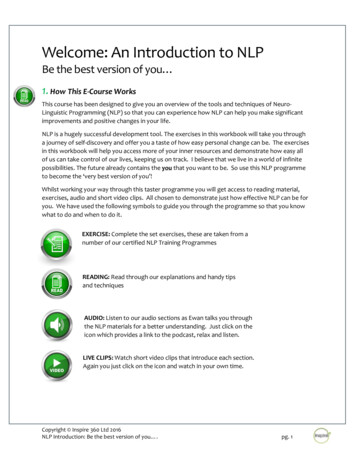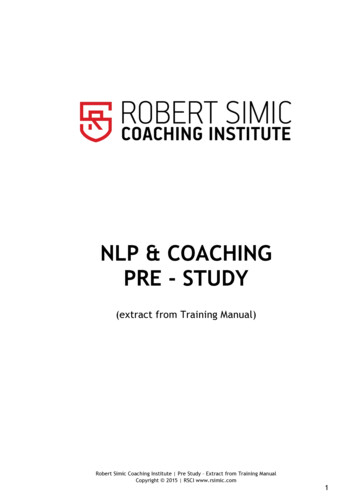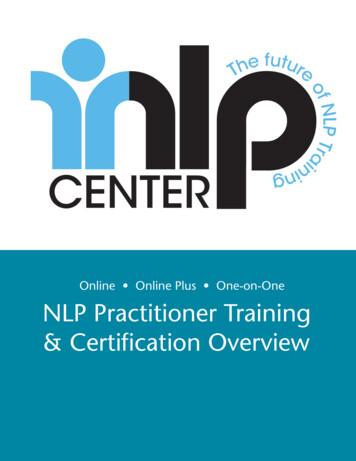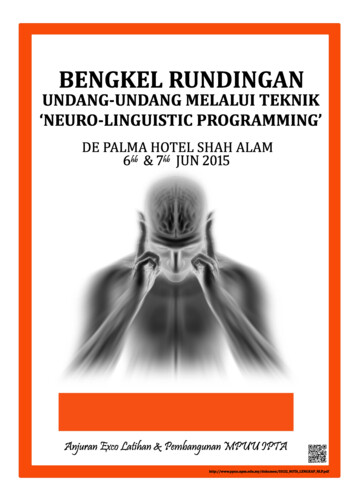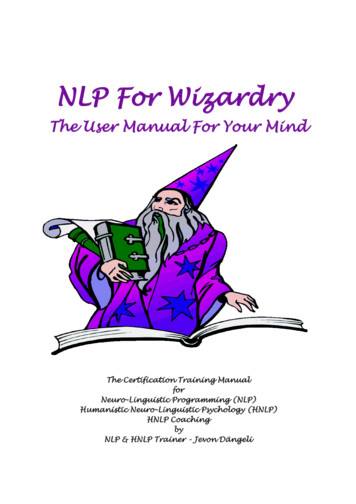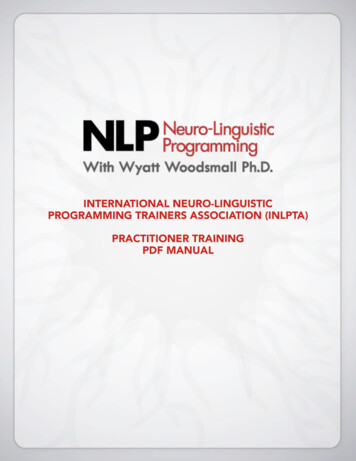
Transcription
INTERNATIONAL NEURO-LINGUISTICPROGRAMMING TRAINERS ASSOCIATION (INLPTA)PRACTITIONER TRAININGPDF MANUAL
INLPTA Practitioner Training2TABLE OF CONTENTSTHE MIND AND HOW IT WORKSCOMMUNICATION PRINCIPLESNLP IS:NLP ATTITUDEELEMENTS OF ATTITUDENLP CHANGE PROCESSKINDS OF TECHNIQUES/SKILLSADVICENEURO-LINGUISTIC PROGRAMMINGCALIBRATION: HOW TO GET FEEDBACK AND TEST UNDERSTANDINGRAPPORT: THE KEY TO TRUST AND RESPONSIVENESSRAPPORTCOMMUNICATION: THE CONSTRUCTION OF LEVERAGEHOW TO COMMUNICATE WITH PRECISIONANCHORINGLINKING A CHOSENSTIMULUS WITH A DESIREDRESPONSEANCHORINGACCESSING CUESAPPENDICESINLPTANLP PractitionerWritten IntegrationENGLISH GRAMMAR 2010 Wyatt Woodsmall Ph.D.34556777816171923242727272729445161616174
INLPTA Practitioner Training3THE MIND AND HOW IT WORKSOur brain has two halves. The left side is linear, logical, analytic and contains thelanguage center of the brain. The right side is involved in creativity, pattern recognitionand synthesis.We also have both a conscious and an unconscious mind. The conscious mind iscapable of reasoning and planning. The unconscious controls most of our behavior.We will use language to program our brains to be more effective trainers andconsultants.The model we will use is based on four general principles: Know your outcome. Have sufficient sensory acuity to know if what you are doing is moving youtoward your outcome. Vary your behavior until you get the response that you want. Take action now.Presuppositions of Success: The meaning of a communication is the response that you get.The map is not the territory.Language is a secondary representation of experience.Mind and body effect each other.In any system that element with the greatest flexibility of behavior or range ofchoices will control the system.Behavior is geared toward adaption.Under every behavior is a positive intent.People have all the resources they need to make the changes they want.Possible in the world and possible for me is only a matter of how.The highest quality information about people is behavioral.It is useful to make a distinction between behavior and self.There is no such thing as failure, but there is only feedback.A salesmen and a buyer form a cybernetic system and each affects the other. 2010 Wyatt Woodsmall Ph.D.
INLPTA Practitioner TrainingCOMMUNICATION PRINCIPLES1.2.3.4.5.6.Communication is based on perception.People actively try to make sense out of their environment.Perceptions are organized and structured within a brief period of time.People use stereotypes to organize their perceptions.People tend to see others as similar to themselves.People attempt to maintain their original perceptions regardless of contradictoryinformation.7. People feel obligated to repay others regardless of whether they like the gift orthe giver.8. People have a need to be consistent.9. People are more easily influenced by others they perceive as similar to themselves.10. People are more easily influenced by people they like.11. The perception of credibility increases with the perception of authority.12. People are more easily influenced when they believe the source to be scarce orvaluable.13. People are more easily influenced by those they perceive as credible.14. The perception of credibility is based on three factors:1) competence/expertness2) trustworthiness3) dynamism.15. People are influenced by the way the message is structured and delivered.16. The perception of credibility is influenced by personal attributes.17. People choose leaders rapidly and on limited information.18. People use information other than facts in making decisions.19. People make decisions by emotions (unconscious mind) and validate them withlogic (conscious mind).20. People more easily retain information which is anchored.21. People seek to render a judgement which they perceive as equitable. 2010 Wyatt Woodsmall Ph.D.4
INLPTA Practitioner TrainingNLP IS: Attitude Methodology Trail of TechniquesNLP ATTITUDE Be purposive - act from intentionProfessionalism gets resultsWed competence and confidenceFlexibility: be outrageous or crazyExperiment: try thingsView life as a challengeUse common sense: take only calculated risksBe fascinated and curious:ask howwide eyed factorawe and radical amazement Always act from integrity 2010 Wyatt Woodsmall Ph.D.5
INLPTA Practitioner TrainingELEMENTS OF ATTITUDE12 C’s nces12 E’s 4 I’s liminate ionality 2010 Wyatt Woodsmall Ph.D.6
INLPTA Practitioner TrainingNLP CHANGE PROCESS Put self in optimum physiology, attitude and mental spaceGet and maintain rapportGather information on present state and desired stateDo ecology checkDetermine outcome and approachUse techniques to produce desired changeTest resultsContextualize and future paceKINDS OF TECHNIQUES/SKILLS Linguistic: what you sayBehavioral: what you doAwareness: what you senseAnalytic: how you thinkEmotional: how you feelADVICE Master basics first, then be creative. Generate new patterns. Always remember that NLP does not end with John and Richard. 2010 Wyatt Woodsmall Ph.D.7
INLPTA Practitioner Training8NEURO-LINGUISTIC PROGRAMMINGNeuro-Linguistic Programming (NLP) was created in the early 1970's by RichardBandler (a computer scientist and Gestalt therapist) and Dr. John Grinder (a linguist andtherapist). They invented a process called "modeling" which enabled them to studythree of the world s greatest therapists (Dr. Milton Erickson who is the father of modernhypnotherapy, Fritz Perls who is the creator of Gestalt therapy, and Virginia Satir who isthe mother of modern day family therapy), to determine what it was that made themeffective and to train others in their methods. What is marketed commercially today asNeuro-Linguistic Programming is the product of this modeling process.Neuro-Linguistic Programming is a set of powerful techniques for rapid andeffective behavioral modification and an operational philosophy to guide their use. It isbased on four operational principles. These are: 1) Know what outcome you want toachieve. 2) Have sufficient sensory acuity to know if you are moving toward or awayfrom your outcome. 3) Have sufficient flexibility of behavior so that you can vary yourbehavior until you get your outcome. 4) Take action now.The importance of having specific outcomes can not be stressed enough. Manypeople do not have conscious outcomes and wander randomly through life. NeuroLinguistic Programming stresses living with conscious purpose. In order to achieveoutcomes it is necessary to act and speak in certain ways. Neuro-LinguisticProgramming teaches a series of linguistic and behavioral patterns that have provedhighly effective in enabling people to change the beliefs and behaviors of other people.In using any of these patterns Neuro-Linguistic Programming stresses the importance ofcontinuous calibration of the person or persons one is interacting with in order to see ifwhat one is doing is working. If it is not working then it is important to do somethingelse. One varies one's behavior until one gets the results one wants. This variation inbehavior is not random, however, but involves the systematic application of the NeuroLinguistic Programming patterns. It is also important to take action, since nothing everhappens until someone takes the initiative. In short Neuro-Linguistic Programming isabout thinking, observing and doing in order to get what one wants out of life.The importance of knowing your outcome can not be stressed enough. Many peopledo not have conscious outcomes. Others have no idea what they want but know whatthey do not want. Their life is based on moving away from those things they do notwant. Neuro-Linguistic Programming stresses the importance of moving toward thosethings that one does want. Without outcomes life becomes a process of wandering 2010 Wyatt Woodsmall Ph.D.
INLPTA Practitioner Training9aimlessly. Once an outcome is determined one can begin to focus on achieving thatoutcome.Neuro-Linguistic Programming lists certain "well formedness conditions" thatoutcomes should meet. The first of these is that the outcome should be stated inpositive terms. This means that the outcome must be what one wants and not what onedoes not want to happen. Outcomes must be things that are capable of being satisfied.It is both logically and practically impossible to give someone the negation of anexperience. One cannot engage in the process of "not doing." One can only engage inthe process of doing.The second well formedness condition for outcomes is that the outcome must betestable and demonstrable in sensory experience. There must be an evidence procedure.Unless this is the case there is no way to measure progress toward the achievement ofthe outcome. With an evidence procedure for the outcome it is possible to determine ifone is making progress toward achieving the outcome or not.Third, the desired state must be sensory specific. One must be able to say what onewould look like, sound like and feel like if one achieved the outcome.Fourth, the outcome or desired state must be initiated and maintained by thesubject. This places the locus of control and responsibility for achieving the outcomewith the subject and not with someone else. It is not a well formed outcome thatsomeone else do something or change in some way. All one can do is have as anoutcome that one change them self or their behavior so as to bring about a change insomeone else.Fifth, the outcome must be appropriately and explicitly contextualized. This meansthat outcomes must not be stated as universals. One must never want something either"all the time" or "never," but only under specific circumstances. In Neuro-LinguisticProgramming one always strives to create more choice and never to take away choice orreduce the number of possible responses. The goal instead is to make the choices orresponses available in the appropriate circumstances.Sixth, the desired outcome should preserve any positive product of the present state.If this is not the case then symptom substitution may occur.Seventh and finally, the outcome or desired state must be ecologically sound. Oneshould consider the consequences for oneself and for other people and not pursueoutcomes that lead to harm to oneself or other people. 2010 Wyatt Woodsmall Ph.D.
INLPTA Practitioner Training10Once one knows their outcome they must next have sufficient sensory acuity toknow if they are moving toward it or not. Neuro-Linguistic Programming teaches theability to calibrate or "read" people. This involves the ability to interpret changes inmuscle tonus, skin color, skin shininess, lower lip size and breathing rate and location.The Neuro-Linguistic Programming practitioner uses these and other indications todetermine what effect they are having on other people. This information serves asfeedback as to whether the other person is in the desired state. An important and oftenoverlooked point is to know to stop when the other person is in the state that onedesires.The third and final operational principle of Neuro-Linguistic Programming is tovary ones behavior until one gets the response that they want. If what one is doing isnot working, then they should do something else. One should use their sensory acuityto determine if what they are doing is leading them in the desired direction or not. Ifwhat one is doing is leading toward one s outcome, then one should continue. If, on theother hand, what one is doing is leading away from their goals, then they should dosomething else.There are certain presuppositions underlying Neuro-Linguistic Programming.These are things that are presupposed in effective communication. Some of thepresuppositions of Neuro-Linguistic Programming are as follows.1) The meaning of a communication is the response one gets. In communication itis usually assumed that one is transferring information to another person. One hasinformation which "means" something to them and intends that the other personunderstand what it is that they intend to communicate. Frequently one assumes that ifthey "say what they mean to say," then their responsibility for the communication isover. Effective communicators realize that their responsibility does not end when theyfinish talking. They realize that for practical purposes what they communicate is whatthe other person thinks they say and not what they intend to say. Often the two arequite different. In communication it is what the other person thinks that one says andhow they respond to it that is important. This requires that one pay attention to theresponse that they are getting. If this is not the response that they want, then they needto vary their own communication until they get the desired response.There are several major sources of "misunderstanding" in communication. The firstarises from the fact that each person has a different life experience associated with eachword in the language. Frequently what one person means by a word (their complexequivalence for that word) may be something quite different than what another person 2010 Wyatt Woodsmall Ph.D.
INLPTA Practitioner Training11means by it. The second arises from the failure to realize that one s tone of voice andfacial expression also communicates information, and that the other person mayrespond to this as much as they do to what is said. As the old saying goes "actionsspeak louder than words," and in Neuro-Linguistic Programming one is trained thatwhen the two are in conflict that one should pay more attention to the actions.2) The map is not the territory. Good communicators realize that therepresentations which they use to organize their experience of the world are not theworld. It is important to distinguish between several semantic levels. First is the world.Second is one s experience of the world. This experience is one s "map" or "model" ofthe world and is different for each person. Each person creates a unique model of theworld and thus lives in a somewhat different reality than anyone else. One does notoperate directly on the world but on one s experience of it. This experience may or maynot be correct. To the extent that one s experience has a similar structure with the worldit is correct and this accounts for its usefulness. One s experience or map or model orrepresentation of the world determines how one will perceive the world and whatchoices one will see as available to them. Many Neuro-Linguistic Programmingtechniques involve changing one s representation of the world to make it more usefuland to bring it more in line with the way the world actually is.3) Language is a secondary representation of experience. Language is a thirdsemantic level. First is the stimulus coming from the world, second is one srepresentation or experience of that stimulus, and third is one s description of thatexperience via language. Language is not experience but a representation of experience.Words are merely arbitrary tokens used to represent things one sees, hears or feels.People who speak other languages use different words to represent the same things thatEnglish speakers see, hear or feel. Also since each person has a unique set of things thatthey have seen, heard and felt in their lives, their words have different meanings to eachof them. To the degree that these meanings are similar people are able to communicateeffectively. When they are too dissimilar then problems in communication begin toarise.4) Mind and body are parts of the same cybernetic system and effect each other.There is no separate "mind" and no separate body." Both words refer to aspects of thesame "whole" or "gestalt". They act as one and they influence each other is such a waythat there is no separation. Anything that happens in one part of a cybernetic systemlike a human being will effect all other parts of the system. This means that one thinkseffects how they feel and that the condition of their physical body effects how theythink. A person s perceptual input, internal thought process, emotional process,physiological response and behavioral output all occur both simultaneously and 2010 Wyatt Woodsmall Ph.D.
INLPTA Practitioner Training12through time. In practical terms this means that one can change how they think byeither directly changing how they think or by changing their physiology or theirfeelings. Likewise one can change their physiology or their emotions by changing howthey think. One important corollary of this, which will be explored later, is theimportance of visualization and mental rehearsal in improving the conduct of anyactivity.5) The law of requisite variety which states that in any cybernetic system includinghuman beings, that element or person in the system with the widest range of behaviorsor variability or choice will control the system. Control in human systems refers to theability to influence the quality of one's own and other people's experience in themoment and through time. The person with the greatest flexibility of behavior, i.e.number of ways of interacting, will control that system. Choice is always preferable tono choice and more choice is always preferable to less choice. This also relates to thethird general principle of Neuro-Linguistic Programming which was mentionedpreviously. This principle says to vary one's behavior until one gets their desiredoutcome. If what one is doing is not working, then one should vary their behavior anddo something else. Anything else is better than what does not work. One should keepvarying their behavior until they find something that does work.6) Behavior is geared toward adaptation. One's behavior is determined by thecontext in which that behavior originates. One's reality is defined by one's perceptionsof the world. The behavior that one exhibits is appropriate to their reality. All of one'sbehavior whether good or bad is an adaptation. Everything is useful in some context.All behavior is, or was, adaptive given the context in which it was learned. In anothercontext it may not be appropriate. People need to realize this and change their behaviorwhen it is appropriate to do so.7) Present behavior represents the very best choice available to that person. Underevery behavior is a positive intent. Given who a person is and based on all of their lifeexperiences and the choices that they are aware of they make the best choice available tothem at any moment in time. If given a better choice they will take it. To changesomeone's inappropriate behavior it is necessary to give them other choices. Once thisis done they will behave accordingly. Neuro-Linguistic Programming has techniquesfor providing these additional choices. Also, in Neuro-Linguistic Programming onenever takes away choices. One only provides more choices and explicitly contextualizesthe existing choices. 2010 Wyatt Woodsmall Ph.D.
INLPTA Practitioner Training138) Behavior is to be evaluated and appreciated or changed as appropriate in thecontext presented. One needs to evaluate their behavior in terms of what they arecapable of becoming. One needs to strive to be all they are capable of being.9) People have all the resources which they need to make the changes they want.The task is to locate or access those resources and to make them available in theappropriate context. Neuro-Linguistic Programming provides techniques toaccomplish this task. What this means is that in practice people do not need to spendtime trying to gain insight into their problems or in developing resources to deal withtheir problems. They already have all the resources which they need to deal with theirproblems. All that is necessary is to access these resources and transfer them to thecurrent time frame.10) Possible in the world and possible for me is only a matter of how. If any otherhuman being is capable of performing some behavior then it is possible for me to alsoperform it. The process of determining "how" they do it is called "modeling" and is theprocess by which Neuro-Linguistic Programming came into being in the first place.11) The highest quality information about other people is behavioral. Listen to whatpeople say but pay more attention to what they do. If there is any contradictionbetween the two, then rely on the behavior. Look for behavioral evidence of change anddon't just rely on people's words.12) It is useful to make a distinction between behavior and self. In other words justbecause one "screws up" on something it does not mean that they are a "screw up."Behavior is what a person says, does or feels at any moment in time. This is not one'sself however. A person's self is greater than their behaviors.13) There is no such thing as failure, but there is only feedback. It is more valuableto view one's experience in terms of a learning frame than in terms of a failure frame. Ifa person does not succeed in something, this does not mean that they have failed. It justmeans that they have discovered one way not to do that particular thing. One thenneeds to vary their behavior until they find a way to succeed.Neuro-Linguistic Programming consists of a set of powerful techniques to effectchange. Some of these techniques are: Anchoring - The process of associating an internal response with some externaltrigger so that the response may be quickly, and sometimes covertly, re-accessedby activating the trigger. Anchors may be naturally occurring or set up 2010 Wyatt Woodsmall Ph.D.
INLPTA Practitioner Training14deliberately. They may be established in all representational systems and serve tocontrol both positive and negative internal states. Stacking Anchors - The process of associating a series of events with one specificanchor so as to strengthen the intensity of the subjects response to a specificanchor. Collapsing Anchors - A process of neutralizing negative states by triggering twoincompatible responses at the same time. Chaining Anchors - A process by which a series of anchors are created to leadfrom an undesired state through a series of intermediary states to a desired state. Associated State - Being fully present in a state so as to experience thekinesthetics of it. For past states this involves being in the experience lookingfrom the perspective of one's own eyes. Dissociated State - Recreating a past experience from the perspective of anonlooker or observer. This means one does not re-experience the originalemotion but instead experiences the emotion of an observer. Double Kinesthetic Dissociation - The process of watching oneself watching amovie of a past experience. This is used in cases of phobias and extreme psychictrauma. Calibration - The process of reading a subject s internal responses in an ongoinginteraction by pairing them with observable behavioral cues. Change History - A process of guiding a subject to re-experience a series of pastsituations by the use of selective anchoring. Resource states are developed foreach situation and installed in the subjects repertoire in order to change thesignificance of the past events. Rapport - The process of establishing a relationship with a subject that ischaracterized by harmony, understanding, and mutual confidence. This is doneby reducing the perceived difference at the unconscious level to a minimum. Reframing - A process used to separate a problematic behavior from the positiveintention of the internal part responsible for that behavior. New choices of 2010 Wyatt Woodsmall Ph.D.
INLPTA Practitioner Training15behavior are established which maintain the positive intent but don t, have theproblematic by-products. Strategy - A set of explicit mental and behavioral steps used to achieve a specificoutcome. This is represented by a specific sequence of representational systems used tocarry out the specific steps. Submodalities - The subclassification of external experience. The decomposing ofa picture, sound, or feeling into its components. 2010 Wyatt Woodsmall Ph.D.
INLPTA Practitioner Training16CALIBRATION: HOW TO GET FEEDBACK AND TESTUNDERSTANDINGSensory acuity is necessary for you to be able to adjust your behavior in response toa customer.The nine key nonverbal indicators to read a person by are:1.2.3.4.5.6.7.8.9.Skin colorSkin shininessMuscle tonusLower lip sizePupil dilationBreathing locationBreathing rateBreathing depthBreathing pausesA person's eyes reveal how they are accessing information.The following charts show the eye accessing patterns for normal right and lefthanded uctAuditoryRememberKinestheticAuditoryDigitalRIGHT HANDED rAuditoryConstructAuditoryDigitalKinestheticLEFT HANDED PERSON 2010 Wyatt Woodsmall Ph.D.
INLPTA Practitioner Training17RAPPORT: THE KEY TO TRUST ANDRESPONSIVENESSRapport according to the dictionary is "a harmonious or sympathetic relation orconnection."It is not necessary that someone like you for them to be in rapport with you.Rapport is the ability to reduce the perceived difference at the unconscious levelbetween you and someone else to the minimum. People like people who are like them.The key to rapport is "pacing" which means meeting the other person where theyare, reflecting what they know or assume to be true, or matching some part of theirongoing experience.Critical things to match and mirror to gain rapport with a person: PostureGesturesVoice toneVoice volumeVoice tempoPeople speak four different languages which are: VisualAuditoryKinestheticDigitalWhen you have achieved rapport with another person they are likely to follow thenext step you take.Leading is doing something different from what the other person is doing andhaving them follow you.Pacing and leading are the road to influence.Sorting by others is the key to successful rapport. 2010 Wyatt Woodsmall Ph.D.
INLPTA Practitioner TrainingThe goal of sorting by others is that the other person feels that you are interested inthem and are concerned about their welfare.Physical indicators of sorting by others are: Eye contact Head nodding Appropriate facial responses Leaning forwardThe goal of pacing is to lead the other person in the direction you want them to go.Persuasion involves validating something someone else already knows to be true,and then leading them to consider and finally to accept other possibilities.Congruence is essential to rapport, since your unconscious gestures can undercutyou.Adopt a resourceful physiology.The most powerful rapport building technique there is the synchronization ofbreathing.Cross over mirroring is a way to pace one aspect of a person's behavior with adifferent aspect of your behavior.Use linear postures if you want to confront.Use non-linear postures to entice a person.Teasing is a way of communicating intent without having to be explicit. 2010 Wyatt Woodsmall Ph.D.18
INLPTA Practitioner Training19RAPPORTNLP operates out of four fundamental principles that separate it from otherdisciplines. These are: 1) Know your outcome. 2) Have sufficient sensory acuity to tellwhether you are moving toward or away from your outcome. 3) Have sufficientflexibility of behavior to vary your behavior until you get the response that you want.4) Take action now. NLP works because it is purposive. An NLP Master always has anaim in any interaction. This is one of the keys to success. The NLP Master is also in uptime with his attention directed toward the other person. This Master also has theability to do whatever it takes to accomplish his outcome. He is a master of the art ofbeing systematically outrageous. Finally he is prepared to take action. He does not justset and wait.There are four keys to success in any human interaction. These are: 1) To putoneself in a state of optimal resourcefulness. This means being physically and mentallyalert and optimally congruent. It is amazing the number of people that go intointeractions in less than resourceful states. This is inexcusable given the power ofresource anchors and NLP change techniques. 2) To have a purpose, aim, direction oroutcome for the interaction. 3) To establish rapport. 4) To have a plan as to how toproceed. This article will focus on the subject of rapport.Rapport is the ability to reduce the perceived difference between you and someoneelse at the unconscious level to a minimum. The person does not have to like you to bein rapport with you. What is important is that they feel comfortable with you at theunconscious level. Two aspects of rapport are pacing and leading. Pacing comes frommatching certain aspects of their behavior until they begin to feel comfortable with you.Once this happens the next step is to begin to lead them in the direction which youwant them to move in. The test is whether they follow your lead. Following your leadis the true test of rapport. If the person does not follow then you have not pacedadequately. At this point go back to pacing and do so with more precision.You can get rapport with the person's conscious mind. The way that one normallydoes that is by sharing interests with the person. NLP focuses on getting rapport at theunconscious level. If you have a choice as to whether you would like to be in rapportwith someone's conscious or unconscious mind, which are you going to go for? Itwould be nice to have both, but if you are going to have only one then go for rapport atthe unconscious level. Pacing and leading are techniques designed to get establishrapport at the unconscious level. 2010 Wyatt Woodsmall Ph.D.
INLPTA Practitioner Training20The secret behind rapport and the reason it works is contained in one sentence. Thisis that we are most comfor
Neuro-Linguistic Programming is the product of this modeling process. Neuro-Linguistic Programming is a set of powerful techniques for rapid and effective behavioral modification and an operational philosophy to guide their use. It is based on four operational principles. These are: 1) Know what outcome you want to achieve.







